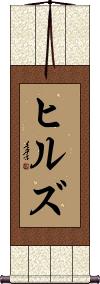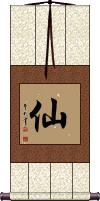Many custom options...
And formats...

Hills in Chinese / Japanese...
Buy a Hills calligraphy wall scroll here!
Personalize your custom “Hills” project by clicking the button next to your favorite “Hills” title below...
Hills
Immortal
仙 means immortal (as in a being or person).
In some contexts, it can mean hermit, ascetic, man of the hills, or wizard. The Buddha is often put in this category.
In Chinese mythology and folklore, there is a famous group of eight immortals (八仙).
The 楞嚴經 (Śūraṅgama Sūtra) speaks of many kinds of immortals including walkers on the earth, fliers, wanderers at will (into space or into the deva heavens), beings with the ability to transform themselves into any form, etc.
Not the results for Hills that you were looking for?
Below are some entries from our dictionary that may match your Hills search...
| Characters If shown, 2nd row is Simp. Chinese |
Pronunciation Romanization |
Simple Dictionary Definition |
仙 see styles |
xiān xian1 hsien hisa ひさ |
More info & calligraphy: Immortal(1) (See 仙人・1) hermit; wizard; (2) (See 仙術) wizardry; (personal name) Hisa 僊 ṛṣi, 哩始 an immortal. 仙人; 人仙 the genī, of whom there is a famous group of eight 八仙; an ascetic, a man of the hills, a hermit; the Buddha. The 楞嚴經 gives ten kinds of immortals, walkers on the earth, fliers, wanderers at will, into space, into the deva heavens, transforming themselves into any form, etc. The names of ten ṛṣis, who preceded Śākyamuni, the first being 闍提首那? Jatisena; there is also a list of sixty-eight 大仙 given in the 大孔雀咒經下 A classification of five is 天仙 deva genī, 神仙 spirit genī, 人仙 human genī, 地仙 earth, or cavern genī, and 鬼仙 ghost genī. |
禪 禅 see styles |
shàn shan4 shan yuzuri ゆずり |
More info & calligraphy: Zen / Chan / Meditation(out-dated kanji) (1) (Buddhist term) dhyana (profound meditation); (2) (abbreviation) Zen (Buddhism); (surname) Yuzuri To level a place for an altar, to sacrifice to the hills and fountains; to abdicate. Adopted by Buddhists for dhyāna, 禪 or 禪那, i.e. meditation, abstraction, trance. dhyāna is 'meditation, thought, reflection, especially profound and abstract religious contemplation'. M.W. It was intp. as 'getting rid of evil', etc., later as 靜慮 quiet meditation. It is a form of 定, but that word is more closely allied with samādhi, cf. 禪定. The term also connotes Buddhism and Buddhist things in general, but has special application to the 禪宗 q.v. It is one of the six pāramitās, cf. 波. There are numerous methods and subjects of meditation. The eighteen brahmalokas are divided into four dhyāna regions 'corresponding to certain frames of mind where individuals might be reborn in strict accordance with their spiritual state'. The first three are the first dhyāna, the second three the second dhyāna, the third three the third dhyāna, and the remaining nine the fourth dhyāna. See Eitel. According to Childers' Pali Dictionary, 'The four jhānas are four stages of mystic meditation, whereby the believer's mind is purged from all earthly emotions, and detached as it were from his body, which remains plunged in a profound trance.' Seated cross-legged, the practiser 'concentrates his mind upon a single thought. Gradually his soul becomes filled with a supernatural ecstasy and serenity', his mind still reasoning: this is the first jhāna. Concentrating his mind on the same subject, he frees it from reasoning, the ecstasy and serenity remaining, which is the second jhāna. Then he divests himself of ecstasy, reaching the third stage of serenity. Lastly, in the fourth stage the mind becomes indifferent to all emotions, being exalted above them and purified. There are differences in the Mahāyāna methods, but similarity of aim. |
ヒルズ see styles |
hiruzu ヒルズ |
More info & calligraphy: Hills |
埡 垭 see styles |
yā ya1 ya |
(dialect) strip of land between hills; used in place names; also pr. [ya4] |
峋 see styles |
xún xun2 hsün |
ranges of hills |
嶙 see styles |
lín lin2 lin |
ranges of hills |
嶧 峄 see styles |
yì yi4 i |
name of hills in Shandong |
渨 see styles |
wēi wei1 wei |
cove; bay; a bend or nook in the hills; the curve of a bow |
牡 see styles |
mǔ mu3 mu hazama はざま |
(of a bird, animal or plant) male; key; hills (noun - becomes adjective with の) (kana only) male (animal); (n-pref,n-suf,n) (1) male; man; (2) (archaism) husband; (personal name) Hazama |
茆 see styles |
mǎo mao3 mao |
type of water plant; (dialect) loess hills |
丘坑 see styles |
qiū kēng qiu1 keng1 ch`iu k`eng chiu keng kukō |
hills and pits |
丘壑 see styles |
qiū hè qiu1 he4 ch`iu ho chiu ho |
hills and valleys; remote, secluded area |
丘陵 see styles |
qiū líng qiu1 ling2 ch`iu ling chiu ling kyuuryou / kyuryo きゅうりょう |
hills (1) hill; hillock; (2) rolling hills; foothills |
双丘 see styles |
soukyuu / sokyu そうきゅう |
(euph) (esp. in erotic literature) breasts; buttocks; two hills |
壞山 坏山 see styles |
huài shān huai4 shan1 huai shan esan |
As the hills wear down, so is it with man. |
山塢 山坞 see styles |
shān wù shan1 wu4 shan wu |
nook; cove (in the hills) |
山水 see styles |
shān shuǐ shan1 shui3 shan shui yamamizu やまみず |
water from a mountain; mountains and rivers; scenery; landscape (1) mountain and water; landscape (containing hills and rivers); (2) (さんすい only) (abbreviation) (See 山水画) landscape picture; (3) mountain stream; water that flows down from a mountain; (4) (さんすい only) (See 築山) garden which contains an artificial hill and a pond; (surname) Yamamizu mountains and rivers |
山野 see styles |
shān yě shan1 ye3 shan yeh yamano やまの |
mountain and fields hills and fields; countryside; (place-name, surname) Yamano hills and fields |
山陵 see styles |
misasagi みささぎ |
(1) mountains and hills; (2) imperial tomb; (place-name) Misasagi |
崗地 岗地 see styles |
gǎng dì gang3 di4 kang ti |
non-irrigated farmland on low hills |
朝山 see styles |
zhāo shān zhao1 shan1 chao shan chouzan / chozan ちょうざん |
(given name) Chōzan To worship (towards) the hills, pay court to a noted monastery, especially to pay court to the Dalai Lama. |
群山 see styles |
qún shān qun2 shan1 ch`ün shan chün shan kunsan クンサン |
mountains; a range of hills mountain range; cluster of mountains; mountainous region; (place-name) Gunsan (South Korea) |
遊山 游山 see styles |
yóu shān you2 shan1 yu shan yusan ゆさん |
excursion; outing; picnic; (given name) Yusan To go from monastery to monastery; ramble about the hills. |
釋迦 释迦 see styles |
shì jiā shi4 jia1 shih chia shaka しゃか |
sugar apple (Annona squamosa) (personal name) Shaka (釋迦婆) Śakra.; Śākya. the clan or family of the Buddha, said to be derived from śāka, vegetables, but intp. in Chinese as powerful, strong, and explained by 能 powerful, also erroneously by 仁charitable, which belongs rather to association with Śākyamuni. The clan, which is said to have wandered hither from the delta of the Indus, occupied a district of a few thousand square miles lying on the slopes of the Nepalese hills and on the plains to the south. Its capital was Kapilavastu. At the time of Buddha the clan was under the suzerainty of Kośala, an adjoining kingdom Later Buddhists, in order to surpass Brahmans, invented a fabulous line of five kings of the Vivartakalpa headed by Mahāsammata 大三末多; these were followed by five cakravartī, the first being Mūrdhaja 頂生王; after these came nineteen kings, the first being Cetiya 捨帝, the last Mahādeva 大天; these were succeeded by dynasties of 5,000, 7,000, 8,000, 9,000, 10,000, 15,000 kings; after which long Gautama opens a line of 1,100 kings, the last, Ikṣvāku, reigning at Potala. With Ikṣvāku the Śākyas are said to have begun. His four sons reigned at Kapilavastu. 'Śākyamuni was one of his descendants in the seventh generation.' Later, after the destruction of Kapilavastu by Virūḍhaka, four survivors of the family founded the kingdoms of Udyana, Bamyam, Himatala, and Sāmbī. Eitel. |
野山 see styles |
noyama のやま |
hills and fields; hill and dale; (place-name, surname) Noyama |
青山 see styles |
qīng shān qing1 shan1 ch`ing shan ching shan seizan / sezan せいざん |
green hills; (the good) life (1) lush mountain; green mountain; (2) (せいざん only) grave; burial place; (given name) Seizan |
京阪奈 see styles |
keihanna / kehanna けいはんな |
(1) (place) Kyoto-Osaka-Nara (esp. the border area of the three); (2) (place) Keihanna Hills (abbreviation); (place-name) Kyoto-Osaka-Nara (esp. the border area of the three); (place-name) Keihanna Hills (abbreviation) |
低丘陵 see styles |
teikyuuryou / tekyuryo ていきゅうりょう |
low hills |
指南宮 指南宫 see styles |
zhǐ nán gōng zhi3 nan2 gong1 chih nan kung |
Zhinan Temple, Taoist temple in the hills of Muzha 木柵|木栅[Mu4 zha4], Taipei |
摩羅耶 摩罗耶 see styles |
mó luó yé mo2 luo2 ye2 mo lo yeh Maraya |
Malaya, the Malabar hills, noted for their sandalwood, cf. 末; also 摩羅延; 摩梨; 摩利伽羅耶; 摩賴耶. |
Click here for more Hills results from our dictionary
The following table may be helpful for those studying Chinese or Japanese...
| Title | Characters | Romaji (Romanized Japanese) | Various forms of Romanized Chinese | |
| Hills | ヒルズ | hiruzu | ||
| Immortal | 仙 | sento / sen | xiān / xian1 / xian | hsien |
Successful Chinese Character and Japanese Kanji calligraphy searches within the last few hours...





